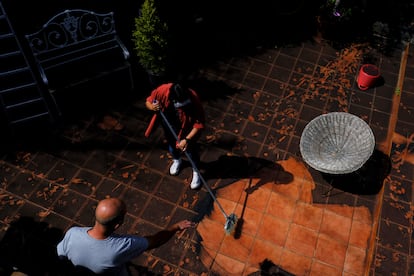La Palma struck by new quake and more destruction from erupting volcano
Air quality has deteriorated while authorities seek to allay fears about new cracks opening up far from the main cone

A 4.3-magnitude earthquake struck on Thursday in La Palma, in Spain’s Canary Islands, where a volcanic eruption has been underway since September 19.
The tremor, registered at a depth of 35 kilometers, is the biggest one on record since that day, according to data collected by the National Geographic Institute of Spain (IGN). It followed on the heels of 16 smaller quakes registered overnight by the IGN.
Authorities sought to allay concerns that this could mean a new crack is about to open on the Cumbre Vieja mountain ridge, leading to new lava flows. “Right now we have no data making us think that a new emission point could open up,” said Miguel Ángel Morcuende, technical director of the Canary Islands’ emergency volcano response department, Pevolca. “We’re not seeing any further land uplift, and that’s positive news.”
But he also added: “What is said about today may not be valid tomorrow.”

Meanwhile, a new stream of lava reached the beach of El Charcón, within the municipal limits of Tazacorte, where it “razed more banana plantations, destroyed several deposits and the odd building,” said the Pevolca spokesman, warning that this new channel of molten rock could cause further damage in the coming days. The main lava flow reached the Atlantic Ocean on September 28, creating a platform that currently covers 38 hectares and continues to expand.
The airport of La Palma was forced to halt flights on Thursday due to a cloud of ash that was being spewed by the volcano on Cumbre Vieja, said Spain’s airport authority Aena. The ash fall did not affect other airports in the archipelago, which is located off the northwestern coast of Africa.
Air quality has also deteriorated due to slow winds that are not effectively clearing up the clouds of ash and sulfur dioxide, said the IGN director in the Canary Islands, María José Blanco. This situation is expected to extend until Saturday, October 9.
“It doesn’t mean that air quality is bad, but if it was good yesterday, today it is so-so,” said Morcuende. “Today it is very important for people with respiratory, lung or heart problems to remain at home and only go out for as short a period as necessary wearing FFP2 masks. All other citizens can carry on with normal masks.”
No casualties have been reported by the volcanic eruption on La Palma, which had been anticipated by scientists. But the lava has already destroyed or damaged over 1,150 properties, and forced 6,000 people from their homes. Morcuende said that the lava has now buried 431.2 hectares of land, and that the main flow now measures 1,250 meters at its widest point.
Ash fall has also affected many of the banana plantations that contribute significantly to the local economy along with tourism. The Spanish government has pledged €206 million in aid for those who have lost their homes and livelihoods to the volcano, which intensified its activity on Sunday with two more fissures on its main cone.
That day, the volcano released 16,000 tons of sulfur dioxide into the atmosphere. This gas, combined with a cloud of dust from the Sahara Desert, reached as far as Puerto Rico, the Caribbean Astronomy Society reported. Experts have predicted that the eruption could go on for weeks or even months. The last such event on the island, registered in 1971, lasted for a little over three weeks.
The Canary Islands are a volcanic archipelago that was created millions of years ago. Some scientists believe there is a “hotspot” underneath the seabed that is causing the current eruption and will lead to the gradual creation of new islands in the area.
Tu suscripción se está usando en otro dispositivo
¿Quieres añadir otro usuario a tu suscripción?
Si continúas leyendo en este dispositivo, no se podrá leer en el otro.
FlechaTu suscripción se está usando en otro dispositivo y solo puedes acceder a EL PAÍS desde un dispositivo a la vez.
Si quieres compartir tu cuenta, cambia tu suscripción a la modalidad Premium, así podrás añadir otro usuario. Cada uno accederá con su propia cuenta de email, lo que os permitirá personalizar vuestra experiencia en EL PAÍS.
¿Tienes una suscripción de empresa? Accede aquí para contratar más cuentas.
En el caso de no saber quién está usando tu cuenta, te recomendamos cambiar tu contraseña aquí.
Si decides continuar compartiendo tu cuenta, este mensaje se mostrará en tu dispositivo y en el de la otra persona que está usando tu cuenta de forma indefinida, afectando a tu experiencia de lectura. Puedes consultar aquí los términos y condiciones de la suscripción digital.
More information
Últimas noticias
New York enters the era of Zohran Mamdani
Welcome to the post-religion era: The idea of Christianity as the absolute truth has become obsolete
‘I thought you would like it’: The risky sexual practice popularized by TV shows and TikTok
The digitalization of tourism: ‘They promise experiences and gave us the worst possible one’
Most viewed
- Sinaloa Cartel war is taking its toll on Los Chapitos
- Reinhard Genzel, Nobel laureate in physics: ‘One-minute videos will never give you the truth’
- Oona Chaplin: ‘I told James Cameron that I was living in a treehouse and starting a permaculture project with a friend’
- Why the price of coffee has skyrocketed: from Brazilian plantations to specialty coffee houses
- Silver prices are going crazy: This is what’s fueling the rally










































